Recent Posts
-
IDR 650K
Per Person
Lempuyang Temple Bali Tour
Welcome to our Lempuyang Temple Bali Tour, a journey that will lead you past some of Bali’s most beautiful and famous sites. Our one-day tour package is made to provide you with a memorable experience that is packed with excitement, relaxation, and stunning surroundings.
Join Lempuyang Temple Bali Tour, also referred to as the “Gateway to Heaven,” and take a picture of you appearing to be heading upward with the spectacular Mount Agung in the background. The Tirta Gangga Water Palace, a magnificent royal residence with a labyrinth of ponds, fountains, and statues encircled by beautiful gardens, as well as the Tukad Cepung Waterfall, a hidden gem nestled away in a cave-like environment, will also be on our itinerary.
You will be led during the tour by one of our knowledgeable and personable tour guides, who will also make sure that you are secure and comfortable while giving you explicit consideration of Bali’s history and culture.
This Lempuyang Temple Bali Touris ideal for anyone seeking an adventure that combines Bali’s natural beauty and its extensive cultural legacy. So come and join Lempuyang Temple Bali Tour for a day that will leave you with lifelong memories that are truly unforgettable.
Place to Visit
Lempuyang Temple (Gate of Heaven)
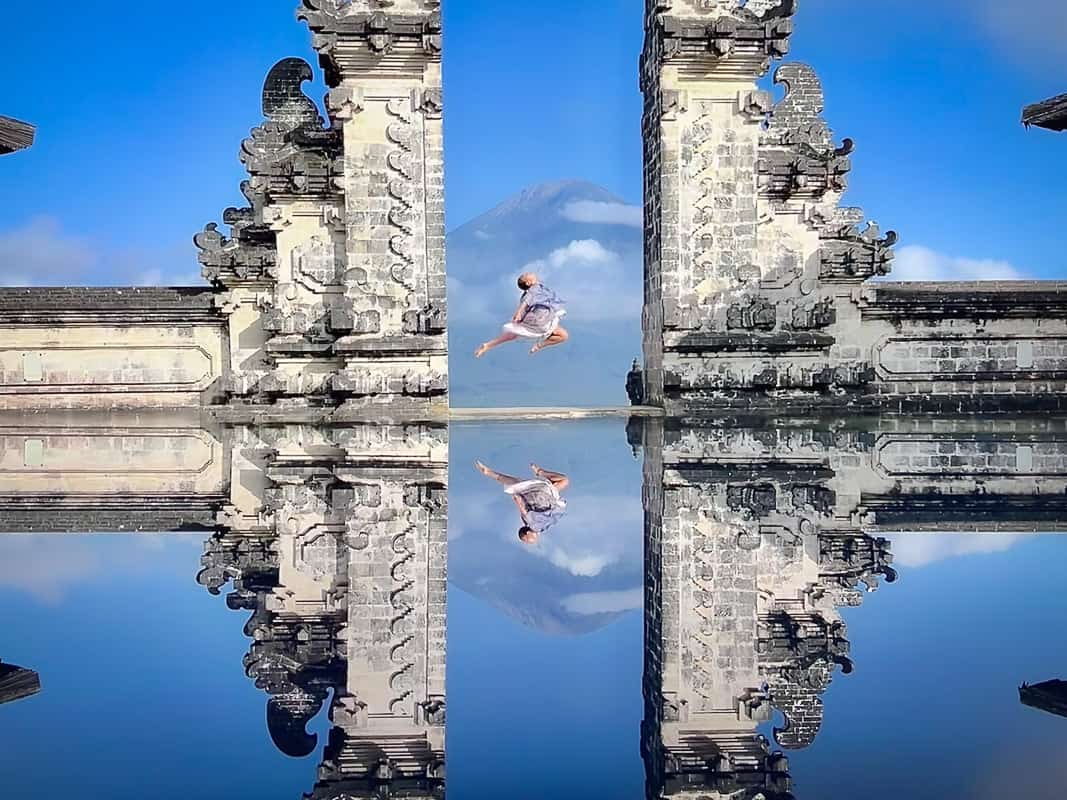
The complex of Balinese Hindu temples known as Lempuyang Temple is situated in East Bali, Indonesia. It is also referred to as Pura Lempuyang Luhur or the Gate of Heaven. It is located at an elevation of 1,175 meters above sea level on the slope of Mount Lempuyang and provides breathtaking views of the nearby hills and mountains.
Seven temples make up the complex, each of which is located on a different level and connected by a flight of stairs that leads to the main temple at the summit. Three imposing split gates, known as Candi Bentar and considered the entryway to the sacred sanctuary, mark the transition from the outside world to the inner realm of the gods in the main temple.
The Gate of Heaven, which is situated at the top of the stairs leading to the main temple, is the most well-known aspect of the Lempuyang Temple. The Gate of Heaven is a frame-like building that offers visitors a breathtaking photo opportunity by precisely framing the view of Mount Agung, Bali’s highest volcano.
Balinese Hindus consider the temple to be a significant place of worship and frequently come here to pray and make offerings to the gods. Guests are welcome to tour the temple grounds and observe the priests and worshippers performing their regular rituals.
The Lempuyang Temple entrance is free, but visitors must dress appropriately, which includes wearing a sarong and a sash. It’s also crucial to behave responsibly and avoid causing any disruptions in order to respect the temple and its holiness.
Tirta Gangga Water Palace
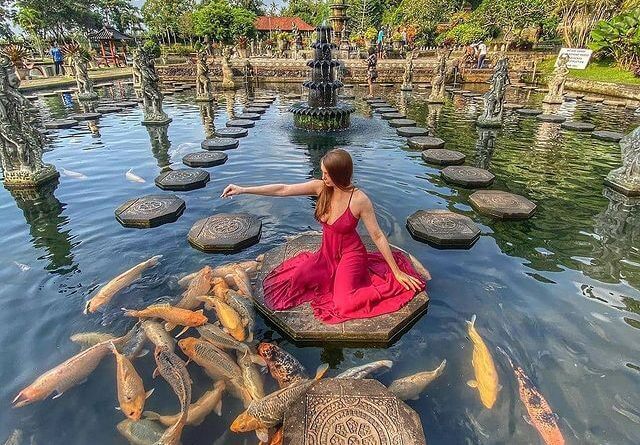
Tirta Gangga Water Palace is a popular major tourist destination in the eastern part of Bali, Indonesia. The palace was completed in 1946 by the last king of Karangasem, Anak Agung Anglurah Ketut Karangasem. It is a lovely complex of pools, fountains, and gardens nestled among lush green rice terraces and bordered by hills.
The water palace is notable for its gorgeous and elaborate Balinese architecture, which combines Hindu and Chinese elements. The palace is built around a natural spring that feeds three different pools, each with its own distinct personality and architecture.
The palace’s highlight is the first and largest pool, which is filled with crystal clear water teamed with koi fish. The second pool is the most sacred and is encircled by statues of mythical creatures. The third pool is a smaller, more secluded pool ideal for peaceful reflection and relaxation.
Aside from the pools, the palace has various exquisite fountains, stone carvings, and Hindu deity statues. The lovely gardens filled with brilliant flowers, coconut palms, and other tropical flora can be enjoyed by visitors as they stroll about the royal grounds.
Tirta Gangga Water Palace is not just a lovely tourist destination, but it also has cultural and religious significance for the Balinese. It is regarded as a spiritual healing center and is frequently utilized for religious ceremonies and rituals.
Tirta Gangga Water Palace is a must-see for anyone interested in Balinese culture and architecture, or who simply wants to escape the rush and bustle of daily life.
Tukad Cepung Waterfall
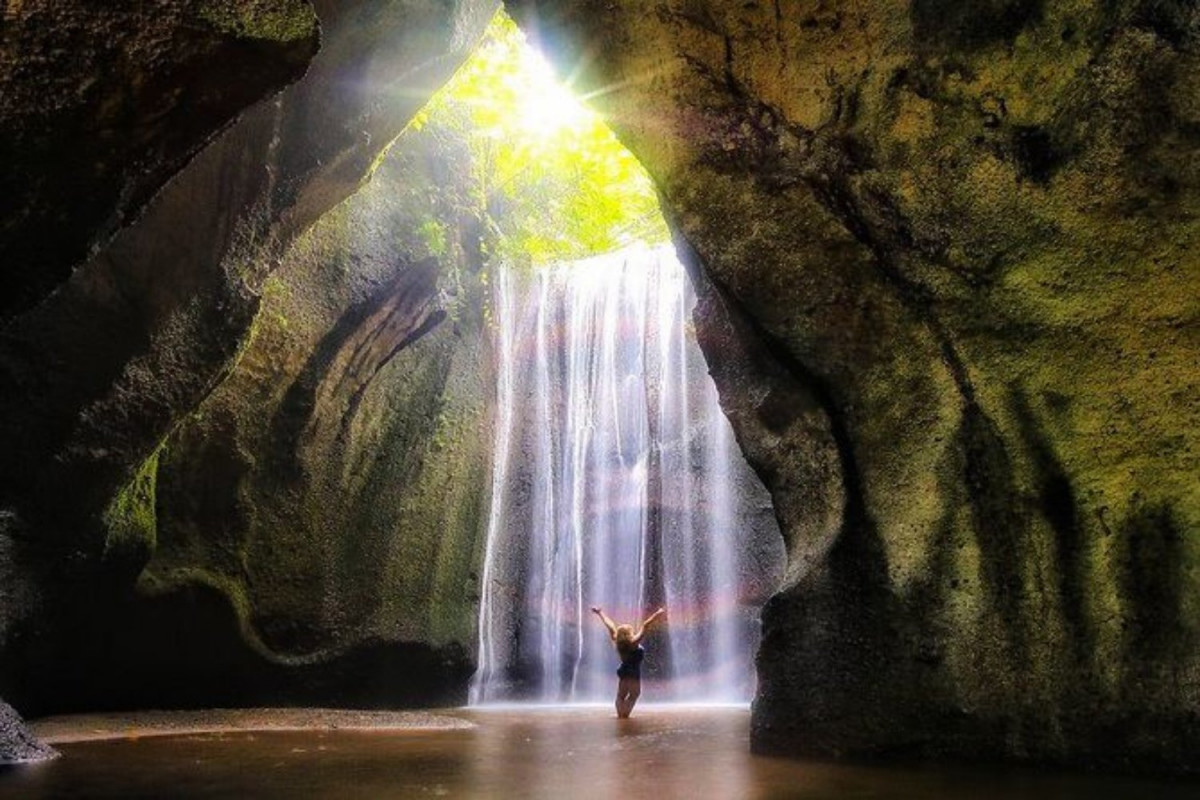
Tukad Cepung Waterfall is a hidden gem in Bali, Indonesia, located in the town of Tembuku, Bangli regency. It is a natural waterfall concealed inside a cave that is one of the island’s most remarkable and gorgeous waterfalls.
A stream passes through a short canyon and cascades into a pool below to make the waterfall. The waterfall is surrounded by steep rocks, and the sun’s rays filter through the narrow entrance of the cave, illuminating the cascade and the lake below.
Visitors must travel down a rough and slippery route through the lush jungle for about 15 minutes to reach the waterfall. The hike can be difficult, but it is well worth it for the breathtaking views of the waterfall and natural environs.
The greatest time to visit Tukad Cepung Waterfall is early in the morning when the sun’s rays are at their brightest and create the most magnificent light show. It is also less busy at this time, allowing tourists to experience the waterfall’s magnificence in private.
Guests can relax in the cool, soothing water of the pool below the waterfall. By the waterfall’s entrance, there are several tiny booths selling drinks and food.
Finally, Tukad Cepung Waterfall is a one-of-a-kind and spectacular location that nature enthusiasts and adventure seekers visiting Bali should not miss.
We appreciate your interest in our Lempuyang Temple Bali Tour! We think you’ll never forget your trip to the magnificent Lempuyang Temple (Gate of Heaven), the tranquil Tirta Gangga Water Palace, and the beautiful Tukad Cepung Waterfall. Your trip through the heart of Bali will be safe and unforgettable thanks to our skilled and hospitable guides.
Don’t pass it up this chance to see some of Bali’s most breathtaking sights. Make your reservation right away, and we’ll take you on an unforgettable journey!
Tour Itinerary
08:00 – Pick up at the hotel
11.00 – Visit Lempuyang Temple (Gate of Heaven)
13.00 – Visit Tirta Gangga Water Palace
14.00 – Lunch
15.30 – Visit Tukad Cepung Waterfall
16.30 – Back to the hotel
18.00 – Arrive at the hotel
Area Covered for Pick Up
Seminyak, Legian, Kuta, Nusa Dua, Jimbaran, Pecatu, Sanur, Ubud, Canggu, Denpasar, Benoa Harbour, Airport.
Please contact us for pick up in the different area.
Booking and Payment
- Fill in and submit the booking form
- Payment is Cash to your driver
-
DepartureHotel/ Villa
-
Departure Time8:00 AM
-
Return Time6:00 PM
-
IncludedPrivate tourComfortable Car with Air ConditionerSpeaking English DriverPetrol for carEntrance Fee TicketsMineral waterParking feesGovernment taxes
-
Not IncludedPersonal expenses
Similar Tours
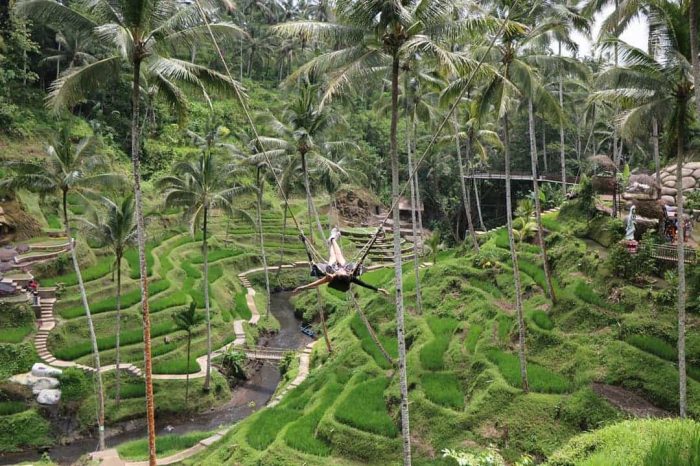
IDR 650K
Bali Swing Tour and Ubud Tour
A thrilling adventure activity that has grown tremendously popular among visitors to Bali is the Bali Swing Tour. Visitors are led on a tour to a spot where a huge swing has been erected between two big trees, offering breathtaking views of the surrounding jungle and rice terraces. Visitors can swing alone or with a partner; the swing is often composed of sturdy ropes. Swinging above the earth while seeing the gorgeous surroundings is a thrilling experience.
Often, the Bali Swing Tour includes extra excursions like zip lining, trekking, and visiting picturesque surroundings. The on-site restaurant serves a range of regional and foreign cuisine, and visitors may also have a delectable lunch or snack there.
The Ubud Tour, on the other hand, is a cultural and sightseeing tour that takes travelers to Ubud, a town noted for its rich cultural legacy and stunning scenery. The town is located in the center portion of Bali, and it is generally referred to as the cultural heart of the island. Visits to historic temples, rice terraces, art galleries, and traditional Balinese communities are common on the Ubud Tour.
The Monkey Forest, a sanctuary for the Balinese long-tailed monkey, is one of the highlights of the Ubud Tour. Guests can view and even feed the monkeys in their natural habitat.
The Ubud Tour is an excellent way to immerse yourself in local culture while also experiencing Bali’s natural beauty. Visitors can watch traditional dance performances, learn about the region’s traditional handicrafts and art, and even try their hand at some Balinese crafts. Stops at local markets and stores let visitors purchase souvenirs and other traditional Balinese products.
The Bali Swing Tour and Ubud Tour provide travelers visiting Bali with one-of-a-kind and amazing experiences. These trips are a terrific way to see the beauty and diversity of this amazing island, whether you’re looking for adventure or cultural immersion.
Place to Visit
Bali Swing Tour
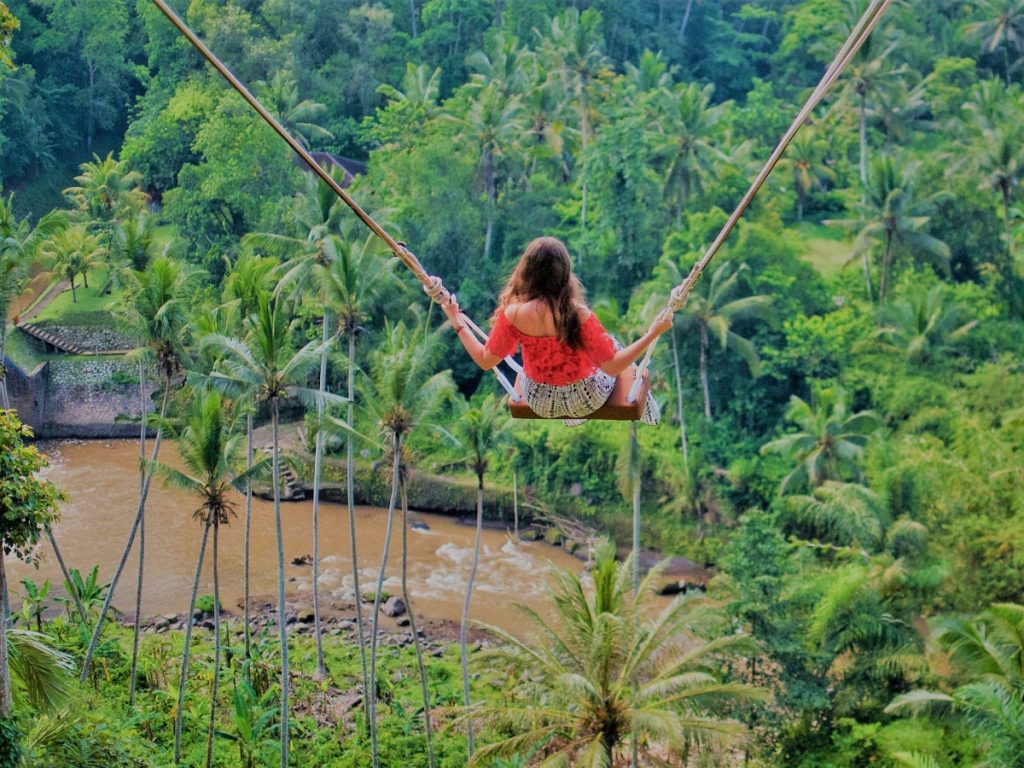
The Bali Swing Tour is an extremely popular adventure activity among tourists visiting Bali, Indonesia. It is a once-in-a-lifetime opportunity for guests to swing far above the beautiful green jungle and rice terraces, with breathtaking views of the surrounding countryside. In this overview, we will go through the Bali Swing Tour in depth.
During a standard Bali Swing Tour, a large swing is built between two large trees in a gorgeous setting. The swing, which is typically hanging over a cliff or a valley and composed of sturdy ropes, gives users an exhilarating sensation as they soar above the earth. It is the ideal place for selfies and photos since it provides stunning views of the nearby forest, rice terraces, and rivers.
A range of swings, including single swings, tandem swings, and swings big enough to fit groups of people, are available for guests to select from on the Bali Swing Tour. All ages of visitors are catered for by the swings, and safety precautions are taken to guarantee that swinging guests are secure.
The Bali Swing Tour often includes other activities in addition to swinging, such as zip lining, trekking, and taking in the breathtaking scenery. The on-site restaurant, which serves a range of regional and international cuisine, also welcomes visitors to indulge in a tasty lunch or snack. Visitors can enjoy great views of the surrounding countryside because the restaurant is often situated in a beautiful area.
The Bali Swing Tour is a fantastic opportunity to spice up your trip to Bali and make lifelong memories. For those looking for a distinctive and exhilarating experience, it is a must-do activity. The tour may be tailored to fit varied interests and budgets and is appropriate for singletons, couples, families, and groups of friends.
The Bali Swing Tour is an adventurous activity that provides tourists with a distinctive and exhilarating experience. It offers stunning views of the surrounding area and is a wonderful opportunity to make priceless memories. The Bali Swing Tour is a must-do when in Bali, whether you’re looking for excitement, leisure, or both.
Tegalalang Rice Terrace
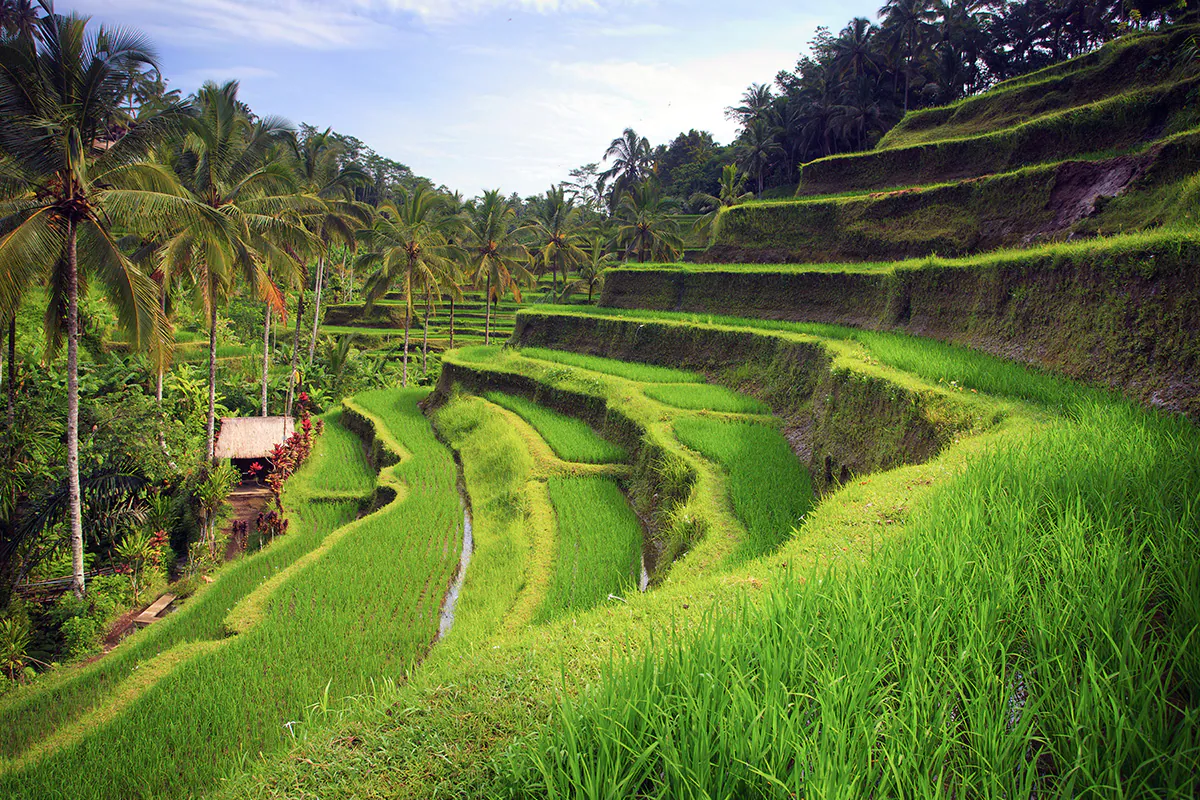
Tegallalang Rice Terrace is one of the most iconic and scenic landscapes in Bali, Indonesia. Located in Tegallalang village about 10 kilometers north of Ubud, it is one of Bali’s most popular tourist attractions. This overview details the Tegalalang Rice Terrace.
The Tegalalang Rice Terraces are vast rice fields carved into a terraced landscape. The rice terraces have been formed and maintained by generations of Balinese farmers who use a traditional irrigation system called ‘subak’ to irrigate the rice fields. A UNESCO World Heritage Site, the Subak System is an intricate network of canals and water temples used to supply water to rice fields.
Tegallalang Rice Terrace is the perfect place to experience the natural beauty and traditional culture of Bali. The terraces are set between hills and valleys, allowing visitors to take leisurely strolls through the rice fields and enjoy the fresh air and peaceful atmosphere. Especially during the rice planting and harvesting season, the rice fields are lush and green, and the scenery is spectacular.
In addition to the natural beauty of Tegalalang Rice Terrace, visitors can also learn about traditional Balinese rice cultivation methods. There are many small stalls and shops in the surrounding area, where visitors can purchase local handicrafts and souvenirs, or enjoy local cuisine at various restaurants and cafes. Visitors can also experience traditional Balinese dances and cultural events taking place in the area.
Tegalalang Rice Terrace is a must-see for anyone visiting Bali. A unique and authentic glimpse into the traditional Balinese way of life, with stunning views of the natural landscape. Whether you’re looking for a peaceful stroll through the rice fields or a cultural experience, the Tegalalang Rice Terrace is an attraction that should not be missed.
Ubud Monkey Forest
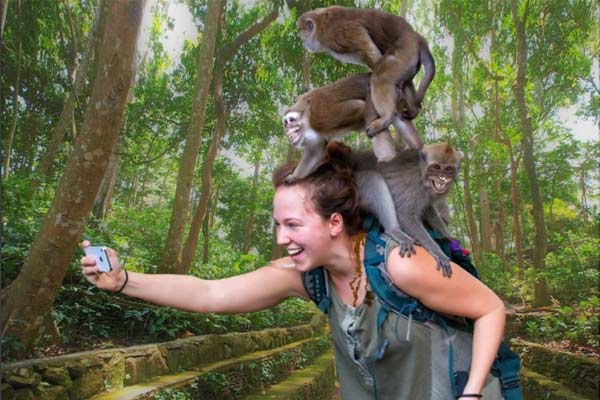
The Ubud Monkey Forest is a prominent tourist attraction located in the middle of Ubud, Bali, Indonesia. It is one of the area’s few surviving natural woods and a refuge for about 700 long-tailed macaque monkeys. We shall go further into the Ubud Monkey Forest in this overview.
In the midst of a busy Ubud, there lies a stunning and serene refuge known as the Ubud Monkey Forest. It has a surface area of around 12.5 hectares and is made up of multiple old temples, thick rainforests, and tall trees. The well-maintained walkways in the Monkey Forest allow visitors to enjoy a leisurely stroll while admiring the forest’s natural beauty and the playful monkeys living there.
Visitors are urged to use caution and abide by the park’s guidelines since the monkeys at the Ubud Monkey Forest are notorious for their cheeky and mischievous nature. Visitors should be careful with their valuables and refrain from feeding or petting the monkeys because they have been known to steal food and other stuff from unaware tourists.
The Ubud Monkey Forest is also home to a number of significant temples and historic locations in addition to the monkeys. The 14th-century temples are still in use today for everyday rites and rituals. Tourists may tour the temples and discover more about Bali’s distinctive fusion of Hinduism and animism.
For everyone visiting Bali, the Ubud Monkey Forest is a must-see attraction. It gives a special chance to see and interact with monkeys in their natural setting as well as a tranquil escape from the bustle of Ubud. The Ubud Monkey Forest is a must-see destination regardless of your interests in nature, culture, or just having a good time.
Ubud Royal Palace
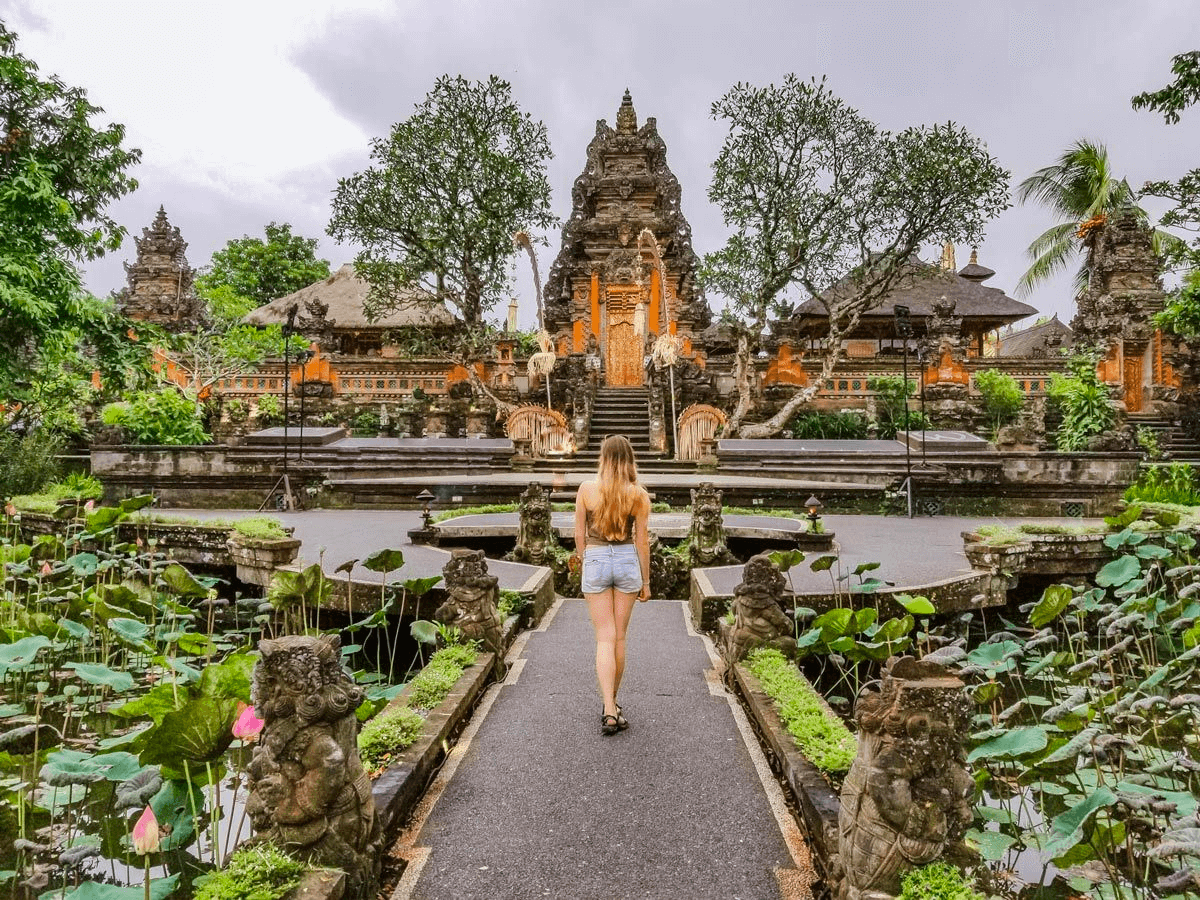
The Puri Saren Agung, often referred to as the Ubud Royal Palace, is a historical palace that is situated in the heart of Ubud, Bali, Indonesia. It was constructed in the early 19th century as the royal family of Ubud’s home and is now accessible to the public as a historical and cultural attraction. We shall delve more into the Ubud Royal Palace in this overview.
A stunning illustration of traditional Balinese architecture is the Ubud Royal Palace. It is a collection of structures that also include a number of pavilions, courtyards, and gardens. High walls surround the palace, which can be entered through a magnificent gate that is manned by statues of fantastical creatures. The palace has beautiful decorations and intricate carvings that showcase the distinctive fusion of Hindu and Buddhist elements in Balinese culture.
Explore the numerous structures and gardens that make up the Ubud Royal Palace complex. Ancient statues, carvings, and fabrics, as well as other significant historical relics and cultural treasures, may be found inside the palace. Via the numerous exhibits and displays that are on show throughout the palace, visitors may also learn about the history and customs of Bali.
Ubud Royal Palace is a must-see for anyone interested in Balinese culture and history. It offers a unique opportunity to explore Bali’s rich cultural heritage and learn about the important role the royal family played in promoting and preserving this heritage. Whether you’re into history and art, or looking for a quiet retreat in the heart of Ubud, Ubud Royal Palace is an attraction not to be missed.
Ubud Market
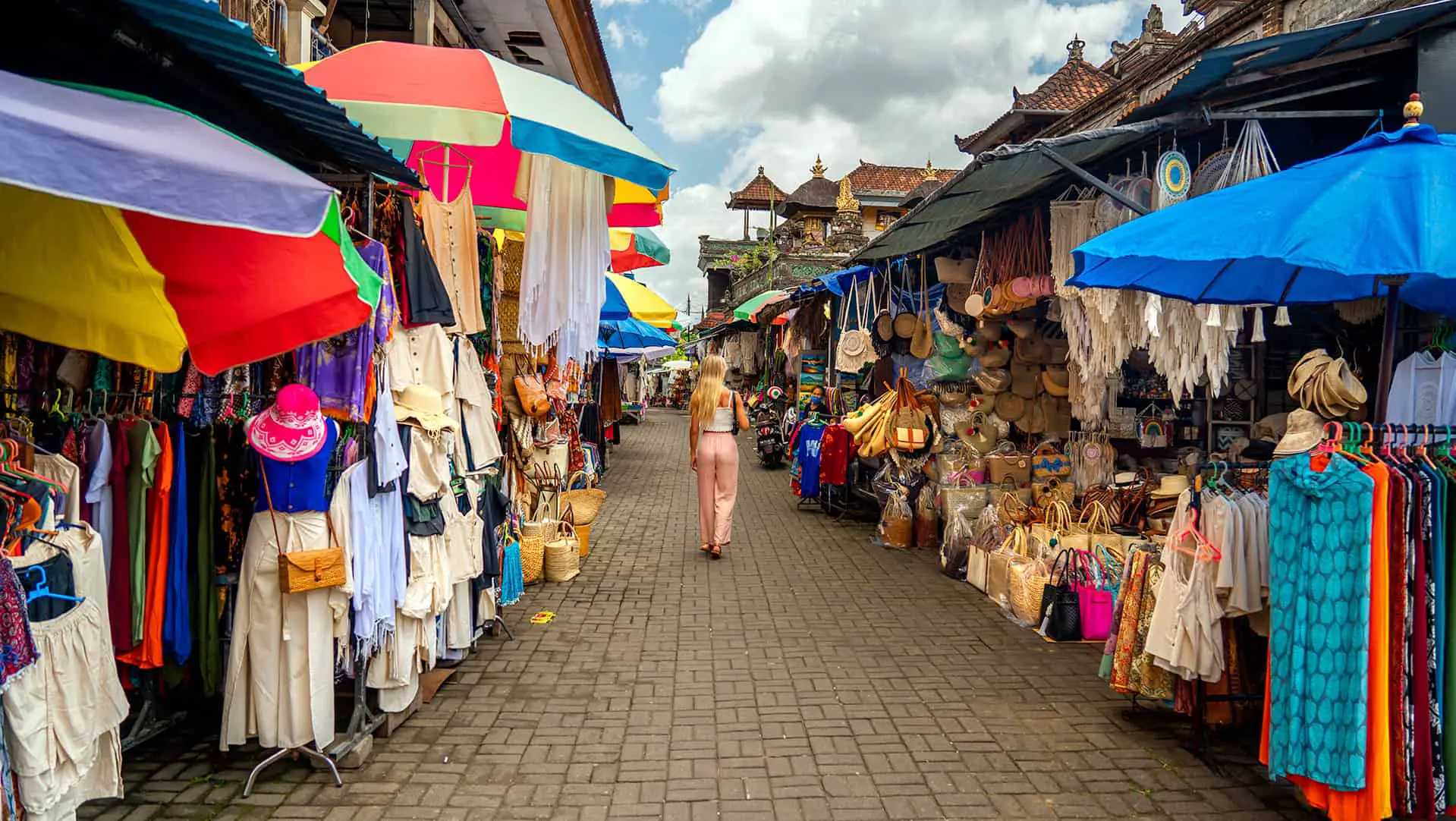
The Ubud Market, also known as Pasar Ubud, is a thriving market in the center of Ubud, Bali, Indonesia. It is one of the largest and most popular markets in Bali and is a key draw for tourists and locals alike. In this overview, we will delve deeper into the Ubud Market.
The Ubud Market is a lively and colorful marketplace brimming with a diverse range of goods and items. Anything from traditional Balinese apparel and handicrafts to fresh fruits and vegetables, spices, and souvenirs may be found at the market. The market is separated into two sections: the traditional market, where fresh produce and household items are offered, and the art market, where handicrafts, textiles, and other souvenirs are marketed.
The opportunity to connect with local sellers and artisans is one of the highlights of the Ubud Market. Many of the merchants are accomplished artisans who handcraft their wares using traditional ways. Visitors can observe the artisans as they weave intricate textiles, carve wooden sculptures, and paint intricate designs on pottery.
The Ubud Market is a terrific spot to find one-of-a-kind and original Bali gifts. Traditional Balinese sarongs and batik textiles, as well as hand-carved masks, jewelry, and sculptures, are available to visitors. The market is also an excellent place to hone your bargaining abilities, as haggling is expected and frequently required to get the best discounts.
The Ubud Market is an excellent spot to experience local cuisine and drink in addition to shopping. Traditional Balinese food and drinks, including fresh fruit juices, coconut water, and local sweets, are available from a number of kiosks and sellers.
Everyone visiting Bali should make sure to visit the Ubud Market. It offers a special chance to get a taste of Bali’s diverse culture and customs and to meet local craftspeople and sellers. The Ubud Market is a must-see destination whether you’re looking to shop, eat, or are just there to take in the ambiance.
Tour Itinerary
08.30 – Pick up from hotel
10.00 – Enjoy Bali Swing Tour
12.00 – Lunch
13.30 – Visit Tegalalang Rice Terrace
15.00 – Visit Monkey Forest
16.00 – Visit Ubud Royal Palace
16.30 – Visit Ubud Market
17.30 – Back to the hotel
18.30 – Arrive at the hotel
Area Covered for Pick Up
Seminyak, Legian, Kuta, Nusa Dua, Jimbaran, Pecatu, Sanur, Ubud, Canggu, Denpasar, Benoa Harbour, Airport.
Please contact us for pick up in the different area.
Booking and Payment
- Fill in and submit the booking form
- Payment is Cash to your driver
1 day
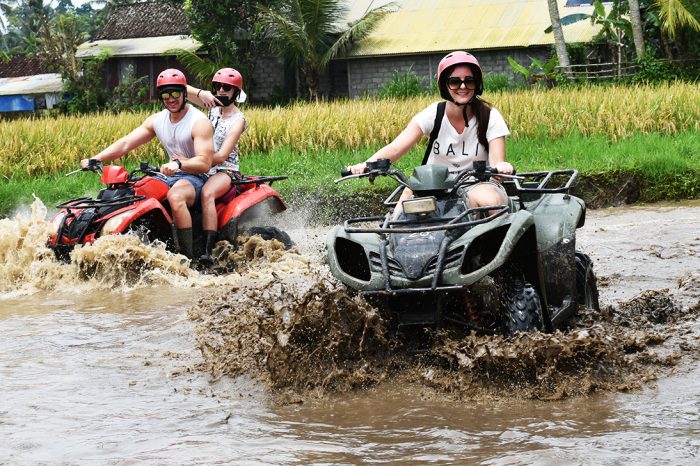
From IDR 800K
ATV Bali Tour And Bali Swing Tour
ATV Bali Tour and Bali Swing Tour are two popular outdoor activities in Bali, Indonesia, offering visitors the opportunity to experience the island’s natural beauty and rich culture.
ATV Bali Tour is an off-road vehicle adventure tour through the scenic landscapes of Bali. Visitors are equipped with safety gear and are guided by experienced instructors as they explore the island’s off-road trails and scenic landscapes. Tours typically include visits to traditional villages, rice paddies, and lush jungles, allowing visitors to experience rural Bali life and culture up close. Suitable for all ages and skill levels, ATV Bali tours are a great way to experience the island’s natural beauty.
The Bali Swing Tour, on the other hand, is an exhilarating activity to swing in Bali’s lush jungle. The tour includes a visit to Bali Swing Park where visitors can choose from different types of swings and choose where they want to swing. Swings range from the simple, offering a gentle rocking motion, to the more adventurous, swinging over cliff edges and offering stunning views of the valley below. The Bali Swing Tour also has several Instagram-worthy photo spots, such as the swallow’s nest and heart-shaped photo frames, making it a popular activity among social media enthusiasts.
Both ATV Bali Tours and Bali Swing Tours offer visitors a unique and unforgettable way to experience the natural beauty and cultural richness of Bali. Popular with families, groups of friends, and solo travelers of all ages and skill levels.
Place to Visit
ATV Ride Adventure
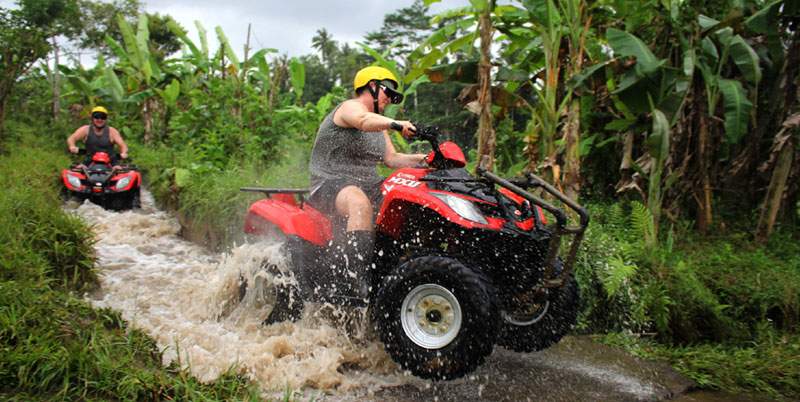
Bali is known for its stunning natural beauty, rich culture, and adventurous activities. The island is a popular tourist destination with millions of visitors each year. ATV Ride Adventure is one of the many exciting activities that attract tourists to Bali. It offers an exciting and unique way to experience the island’s rugged terrain, scenic landscapes, and rich culture.
ATV ride adventure is an important activity for Bali’s tourism industry. Tourism makes an important contribution to the island’s economy, providing employment opportunities and generating income for the local community. This activity is also eco-friendly as the tour is designed to have minimal impact on the natural environment. ATV Ride Adventure operators work closely with local communities and government agencies to ensure that activities are conducted in a responsible and sustainable manner.
Additionally, an ATV ride adventure is a great way to experience Bali’s rural life and cultural heritage. This tour takes participants through traditional villages, paddy fields, and lush jungles to get to know the rich culture and history of the island. Participants can interact with locals and learn about their way of life. An ATV ride adventure is not only an adventure sport but also an educational and cultural experience.
Safety must come first while beginning an ATV Bali Tour. Visitors must follow a safety briefing before starting an ATV riding adventure. The tour’s fundamental standards, norms, and safety precautions are covered at the briefing. The briefing also covers possible hazards, emergency procedures, and information about the terrain. To guarantee their own and others’ safety, it is strongly urged that participants pay close attention to the safety briefing.
Participants will receive ATV driving instructions following the safety briefing. This is to make sure that they feel at ease and self-assured when operating the ATV. The instructor will go through how to operate the ATV’s throttle, brake, and steering as well as give advice on how to navigate various sorts of terrain, including slopes, curves, and water crossings.
Helmets, gloves, and goggles are among the safety gear that is given to participants. The instruments were created to protect the users against potential dangers and harm. Throughout the tour, the helmets must be worn at all times. While the goggles shield the eyes from dust, dirt, and insects, the gloves help you maintain a better hold on the handlebars. All safety equipment is kept up to date and in good working order by the owners of the ATV ride adventure.
The ATV Bali Tour starts with an adventure ride through rice paddies, a jungle, and a river after participants have received a safety briefing and ATV driving instructions. This exhilarating journey offers the chance to discover Bali’s stunning and varied terrain while enjoying the exhilaration of operating an ATV.
The tour will stop at rural communities and picturesque views along the way. Participants can learn more about the local way of life while taking in the breathtaking sights of Bali’s surroundings at these sites.
In addition, there are opportunities to ride through difficult terrains like steep hills, rocky trails, and shallow streams on the ATV Bali Tour. The participants will have a thrilling and adventurous experience thanks to these difficult ride segments.
Jungle Swing at Bali Swing
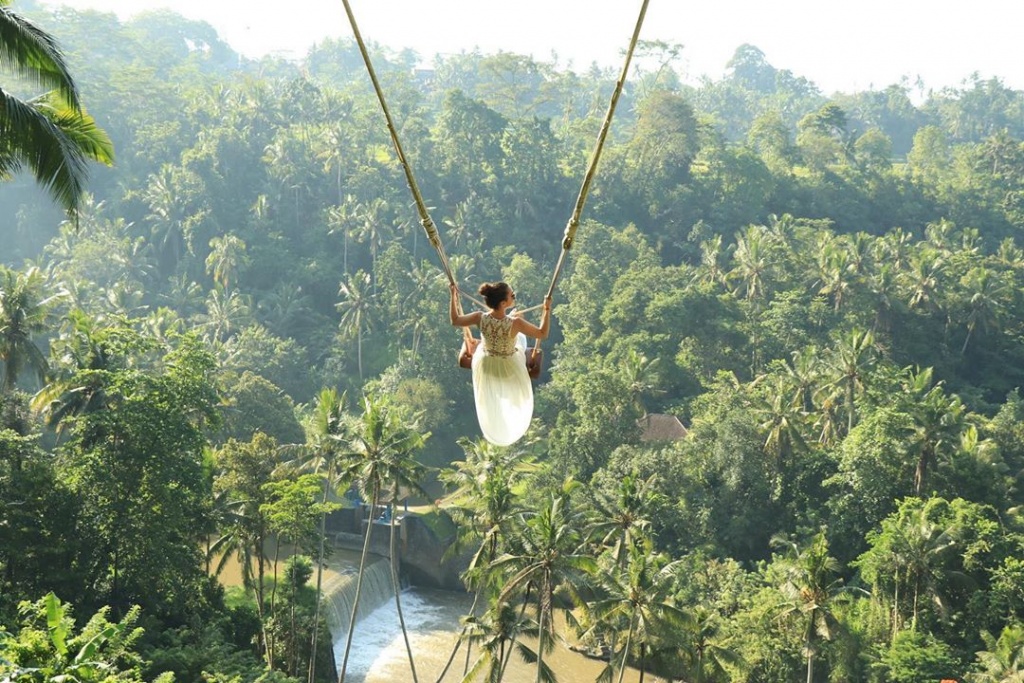
The thrilling jungle swing at Bali Swing whisks you high over the jungle’s treetops and provides breathtaking panoramic views of Bali’s natural splendor. There are numerous swing options, each providing a distinctive experience and level of thrill.
The strong materials used to construct the swings are intended to assure your safety while also delivering an exhilarating experience. You will be safely fastened to the swing via a harness, allowing you to swing without any worries.
For those who wish to take in the view without getting too excited, the most well-known swing is the traditional Bali swing, which offers a slow, peaceful swing. Couples will enjoy the more private swing experience provided by the romantic swing.
The extreme swing is a must-try if you’re searching for a more exhilarating experience. A breathtaking view of the jungle below is provided as you swing out over the cliff’s edge on this swing.
There are other nests and photo locations in addition to the swings where you may take lovely pictures of yourself amidst the stunning Balinese nature.
Overall, our tour package is an ideal choice for anyone seeking an unforgettable experience in Bali. Whether you are a beginner or an expert rider, our ATV Bali tour caters to all skill levels. For those seeking an adrenaline rush, the Jungle Swing at Bali Swing is a must-try experience. So, book your spot today and get ready to immerse yourself in Bali’s natural beauty and adventure.
The ATV Bali Tour and Bali Swing Tour are two of the most thrilling and memorable experiences you can have on the beautiful island of Bali. From the breathtaking views of the lush green forests and rice paddies, to the adrenaline rush of riding an ATV and swinging high above the treetops, these tours offer an adventure like no other.
Not only do you get to explore the natural beauty of Bali, but you also get to immerse yourself in the local culture and traditions. Our friendly and knowledgeable guides will share their insights and stories, making the experience even more meaningful.
So why wait? Book your ATV Bali Tour and Bali Swing Tour now and make memories that will last a lifetime. Whether you’re traveling with friends, family, or on your own, this is an experience that you don’t want to miss. We guarantee that you’ll leave with a smile on your face and a newfound appreciation for the magic of Bali. Thank you for considering our tours, and we hope to see you soon!
Tour Itinerary
08:00 – Pick up at the hotel
10.00 – Enjoy 2 Hours ATV Ride Adventure
12.30 – ATV Ride Finish and enjoy lunch
13.30 – Lunch finish and continue the tour
14.30 – Enjoy Jungle Swing at Bali Swing
16.30 – Back to hotel
18.00 – Arrive at hotel
Tour Prices :
1 person : IDR 1,300,000
2 persons : IDR 975,000/person
3 persons : IDR 875,000/person
4 persons : IDR 825,000/person
5 persons or More : IDR 800,000/person
Area Covered for Pick Up
Seminyak, Legian, Kuta, Nusa Dua, Jimbaran, Pecatu, Sanur, Ubud, Canggu, Denpasar, Benoa Harbour, Airport.
Please contact us for pick up in different area.
Booking and Payment
- Fill in and submit the booking form
- Payment is Cash to your driver
1 day
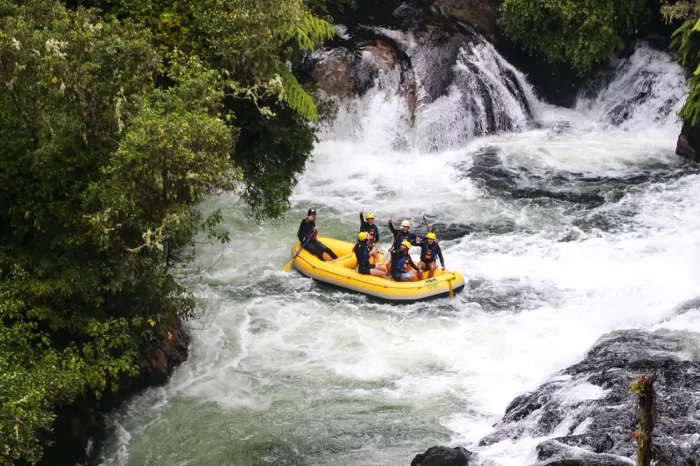
From IDR 250K
Ayung River Rafting Ubud Tour
Ayung River Rafting Ubud Tour is a popular tourist activity that offers a thrilling adventure through the rapids of Bali’s longest river. Located in the heart of Bali, this activity is ideal for those seeking an exciting and fun-filled experience amidst the island’s natural beauty. The journey is an unforgettable experience as participants paddle through lush rainforests, cascading waterfalls, and beautiful gorges. Ayung River Rafting in Ubud promises a unique and adventurous way to explore Bali’s beautiful scenery while also providing a great workout and a sense of achievement.
Ayung River Rafting Ubud Tour promises a thrilling experience full of adventure, natural beauty, and adrenaline. Participants can feel the rush of adrenaline as they traverse the river’s Class II and III rapids, surrounded by spectacular scenery such as tumbling waterfalls, lush green woods, and breathtaking gorges. The journey also provides a unique opportunity to discover Bali’s natural splendor, where travelers can see exotic animals such as monkeys, birds, and fish. The event is ideal for individuals looking for an adventure in the great outdoors and gives an unforgettable experience that will be remembered for a lifetime.
Tour details
Duration of the tour
The duration of the Ayung River Rafting Ubud Tour typically ranges from 2-3 hours, depending on the chosen package and itinerary. This includes time spent on preparation and safety briefing, transportation to and from the river, and the actual rafting experience. However, it’s important to note that the duration may vary depending on factors such as weather conditions, river flow, and the pace of the participants. Some tours also include additional activities such as visits to nearby waterfalls or stop for lunch, which can extend the duration of the tour.
Rafting route
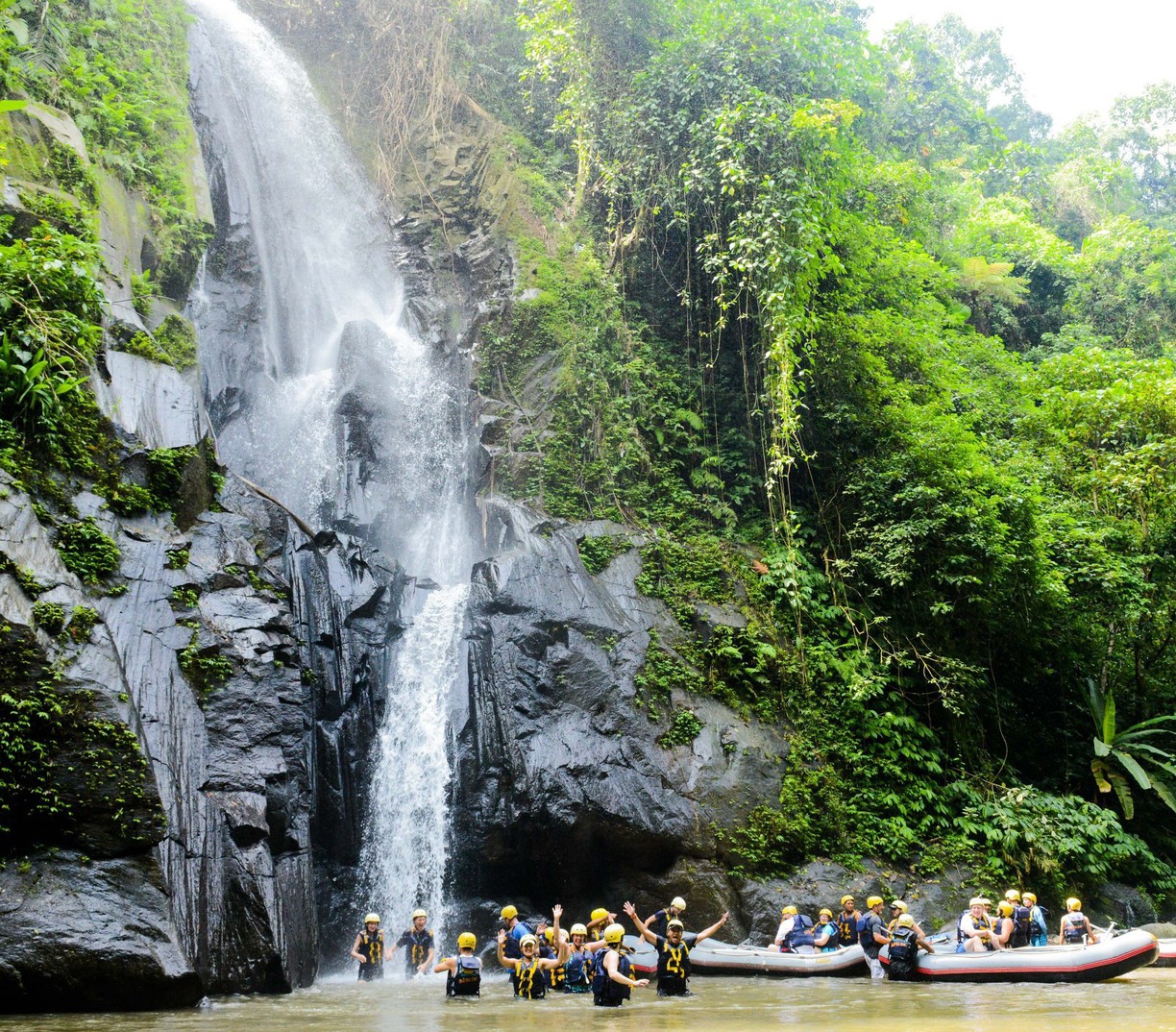
The Ayung River Rafting Ubud Tour route covers a distance of about 10 km in class II to III rapids. The route takes participants through breathtaking natural landscapes, including lush rainforests, cascading waterfalls, and scenic canyons.
The journey begins on a calm river, giving participants time to familiarize themselves with the equipment and paddling. Further along the route, participants will encounter thrilling rapids that will test their paddling skills and provide an adrenaline rush.
Along the way, participants will also have the opportunity to enjoy the natural beauty of Bali, along with the chance to catch a glimpse of exotic wildlife such as monkeys, birds, and fish. Participants can also take a break from rafting to swim in the refreshing river water or bathe in a waterfall.
The Ayung River Rafting Ubud Tour Route also has several attractions, including a short trek to a trailhead where participants can enjoy panoramic views of the surrounding countryside.
Overall, the route offers an exciting and unforgettable experience, showcasing the natural beauty of Bali’s longest river.
Safety precautions and requirements
The Ayung River Rafting Ubud Tour is generally safe, but it’s important to follow safety precautions to ensure a safe and enjoyable experience. Some common safety precautions and requirements include:
- Age limit: Minimum age requirement of 7-8 years old.
- Physical fitness: Participants should be physically fit and in good health to be able to paddle through the rapids.
- Swimming ability: Participants should be able to swim to ensure their safety in case they fall off the raft.
- Safety briefing: Before the tour, a professional guide will provide a safety briefing that covers the proper use of equipment, paddling techniques, and emergency procedures.
- Safety equipment: Participants must wear a life jacket and helmet at all times during the tour.
- Weather conditions: The tour may be canceled or rescheduled in case of extreme weather conditions, such as heavy rain or flooding.
- Follow instructions: Participants must follow the instructions of the guide and be alert during the tour to avoid accidents.
- Medical conditions: Participants with medical conditions such as heart problems, pregnancy, or recent surgeries should consult with their doctor before taking the tour.
It’s important to note that participants should always follow the guidelines provided by the tour operator to ensure a safe and enjoyable experience.
What to wear and bring
It is important to bring appropriate clothing and necessary items to enjoy your Ayung River Rafting Tour in Ubud comfortably. Here are some tips on what to wear and what to bring during your tour.
- Clothes: Please come in clothes that you don’t mind getting wet. Quick-drying clothes such as swimsuits, rash guards, thin T-shirts, and shorts are recommended. Avoid clothes that can get heavy when wet, such as jeans and cotton shirts.
- Footwear: Wear sturdy footwear with good grips, such as sandals or sneakers. Avoid wearing flip-flops or open-toed shoes.
- Sunscreen: Please apply sunscreen to all exposed skin prior to the tour. Wear a hat, sunglasses, or a visor to protect your face from the sun.
- Waterproof bag: Bring a waterproof bag to store valuables such as cameras, mobile phones, and wallets.
- Towel: Please bring a small towel to wipe your body after the rafting experience. Water: Bring a water bottle to stay hydrated during the tour.
- Change of clothes: Please bring a change of clothes after the tour.
- Repellent: Apply repellent to prevent insect bites.
It is also important to follow the tour operator’s safety guidelines and follow the tour guide’s instructions. By following these tips, you can make Ayung River rafting a safe, comfortable, and enjoyable experience on your Ubud tour.
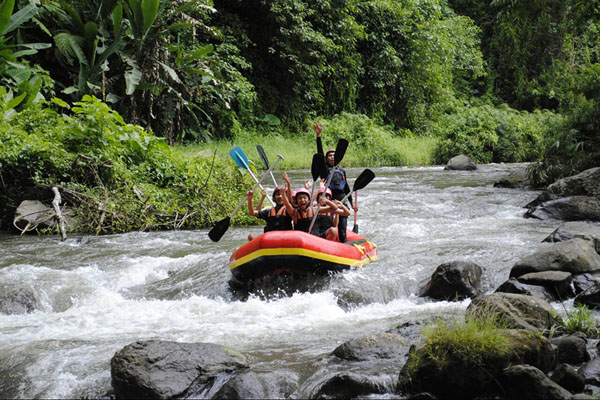
Booking The Ayung River Rafting Ubud Tour is a great way to experience the natural beauty and excitement of Bali. With breathtaking scenery, challenging rapids, and opportunities for adventure, Ayung River Rafting is an experience you won’t soon forget.
Book this tour to explore Bali’s lush rainforests, canyons, and waterfalls from a unique perspective. Feel the adrenaline rush as you navigate the exhilarating rapids of the Ayung River and feel the refreshing water on your face.
Whether you are a seasoned adventurer or a beginner, Ayung River Rafting in Ubud is an experience suitable for everyone. With experienced guides, high-quality equipment, and a commitment to safety, you can enjoy your trip with peace of mind while leaving the details to the professionals.
If you are looking for an unforgettable adventure in Bali, book The Ayung River Rafting Ubud Tour now. You will create memories that will last a lifetime and have experiences that you will always cherish.
Tour Prices :
1 Person : IDR 600.000
2 Persons : IDR 375.000/ person
3 Persons : IDR 300.000/ person
4 Persons : IDR 275.000/ person
5 Persons or More : IDR 250.000/ person
Area Covered for Pick Up
Seminyak, Legian, Kuta, Nusa Dua, Jimbaran, Pecatu, Sanur, Ubud, Canggu, Denpasar, Benoa Harbour, Airport.
Please contact us for pick up in different area.
Booking and Payment
- Fill in and submit the booking form
- Payment is Cash to your driver
1 day
